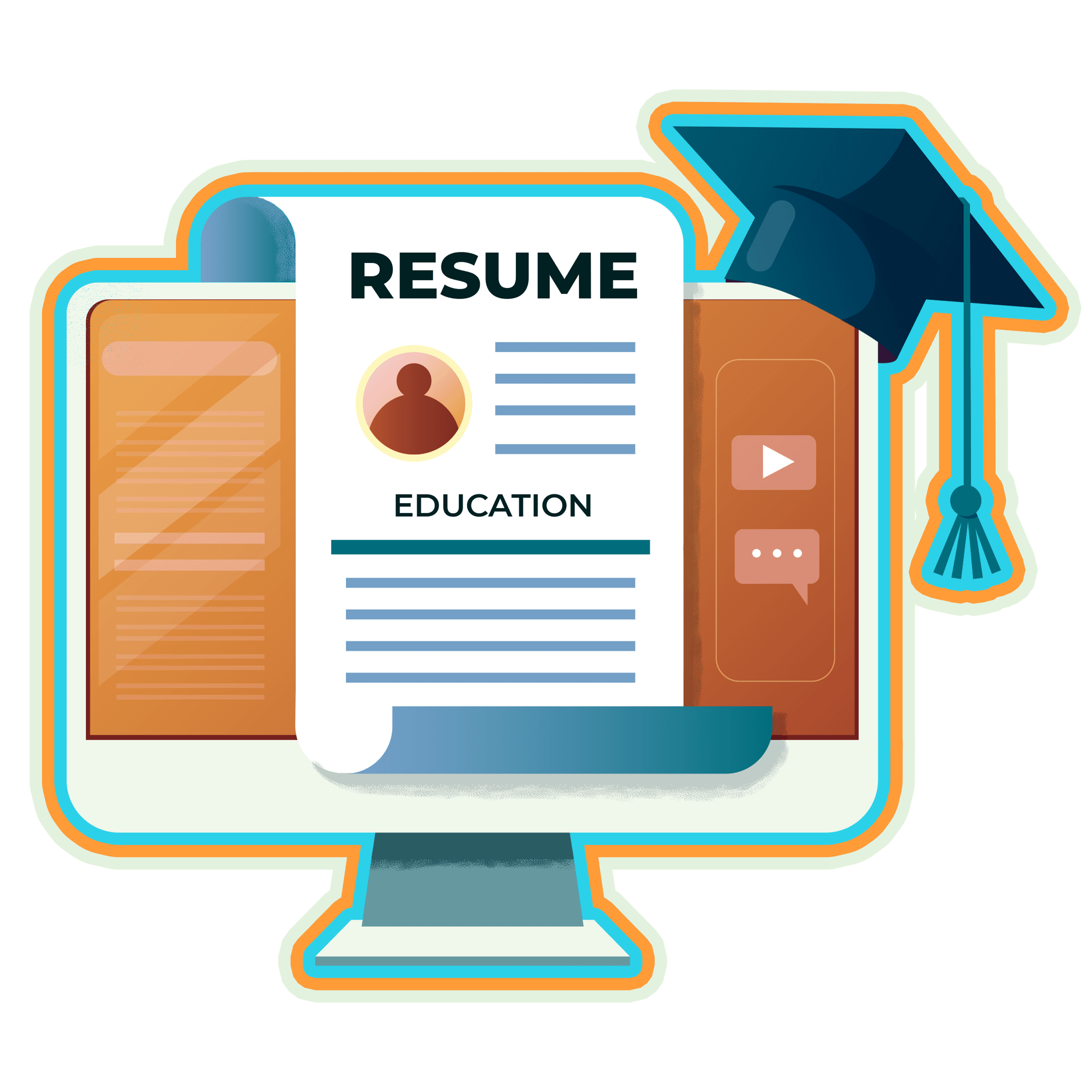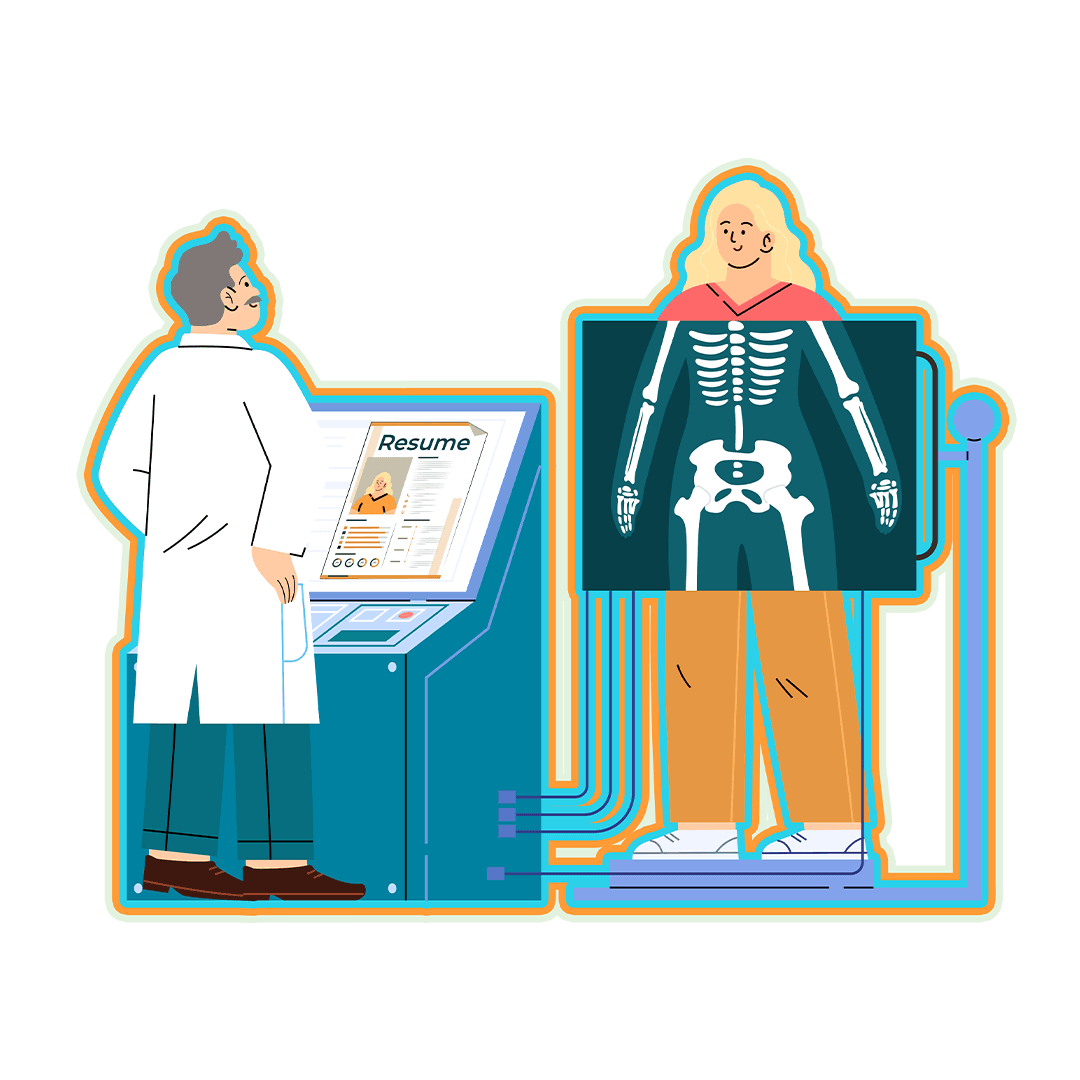Table of Contents
- How to list education on a resume in 7 steps
- Where should education go on a resume?
- What to put under education on a resume
- How to put a degree on a resume
- How to list honors on a resume
- How to list awards on a resume
- How to List Relevant Coursework on Resume
- How To Write Ged On Resume
- How to list minors on a resume
- How to list continuing education on a resume
- Are certifications part of your education on a resume?
The education section of a resume is a critical component that showcases an individual's academic background and qualifications. A resume's education section should come after the objective statement and the professional summary. Recruiters and hiring managers pay particular attention to the education section of the resume since it contains crucial information about academic achievements.
It is more appropriate to place the education section after the work experience section for individuals with extensive work experience and a solid professional background.
Using bullet points to present educational details concisely and effectively is generally recommended.
Listing awards on a resume is essential as it highlights accomplishments and distinguishes you from other candidates. Awards demonstrate skills, dedication, and recognition in the field, making you a more attractive candidate to potential employers.
Listing relevant coursework on a resume involves including a section highlighting the specific courses directly related to the job or industry.
How to list education on a resume in 7 steps
A resume must include information about education because it informs potential employers about credentials and academic background. To effectively list education and leave a good impression, follow the 7 steps.
- Institution: Mention the name of the educational institution.
- Degree: Indicate the degree attained.
- Location: Specify the geographical location of the institution.
- Duration: Include the dates of attendance or graduation.
- Field of Study: Highlight the area of specialization.
- GPA: State the grade point average if it exceeds 3.5.
- Accomplishments: Highlight honors, achievements, relevant coursework, extracurricular activities, or study abroad experiences.
Where should education go on a resume?
A resume's education section should come after the objective statement and the professional summary. Recruiters and hiring managers pay particular attention to the education section of the resume since it contains crucial information about academic achievements. Consider the following factors when determining where to place the education section on the resume.
Placing the education section near the top of the resume ensures it is easily noticeable and accessible. It is particularly advantageous for recent graduates or candidates with limited work experience, allowing them to showcase their academic achievements prominently.
Putting the education section before the work experience section is beneficial if the educational background is directly related to the position. It helps highlight the relevant knowledge and qualifications, capturing the attention of hiring managers prioritizing academic credentials.
It is more appropriate to place the education section after the work experience section for individuals with extensive work experience and a solid professional background. It focuses on professional growth and achievements while providing necessary educational details.
The ultimate goal is to present a well-structured and easy-to-read resume showcasing qualifications and experiences. Tailor the placement of the education section based on unique circumstances and the specific requirements of the job.
Should education be at the top or bottom of a resume?
There is no universal answer to whether education should appear at the top or bottom of a resume. The optimal placement is contingent on factors such as the level of experience, the applicability of the education to the position, and industry standards. Explore different considerations in the list below.
Education or Experience first on the resume
An individual's career stage, job requirements, and industry norms determine whether education or experience should appear first on the resume. Prioritizing education or experience on a resume depends on individual circumstances, such as career stage, job requirements, and industry expectations.
Should the education section on my resume be bulleted?
Using bullet points to present educational details concisely and effectively is generally recommended. Bulleted lists make the information easier to scan and highlight critical issues such as degree, institution, location, and dates attended. Avoid lengthy paragraphs and use clear and succinct bullet points to enhance readability and make a strong visual impact.
What to put under education on a resume
The education section is vital in showcasing the academic background and qualifications. It gives potential employers essential information about educational achievements, certifications, and relevant coursework. To make the most of this section, consider the following points.
- Degree or Certification: Mention the degrees or certifications, such as Bachelor's, Master's, or Ph.D. Include the full name of the degree, the primary or field of study, and the institution from which you graduated.
- Honors and Awards: Highlight academic honors or awards, such as Dean's List, scholarships, or literary excellence awards. It demonstrates exceptional performance and dedication to the studies.
- Relevant Coursework: Including relevant coursework be beneficial if you are a recent graduate with limited work experience. Putting courses directly related to the job on a resume demonstrates the knowledge and skills in specific areas, improving the chances of being hired.
- Thesis or Capstone Projects: Briefly mention any idea, capstone project, or substantial research work completed during the education, if applicable. Provide a concise project overview and emphasize any relevant findings, methodologies, or skills gained.
- Certifications and Licenses: Apart from the formal education, include any certificates or licenses relevant to the position you seek. These may consist of industry-specific certifications like project management or software proficiency certifications.
- Study Abroad or Exchange Programs: Mention any opportunities you had to study abroad or participate in an exchange program if applicable. If you could, highlight the duration, location, and any unique experiences or skills acquired during your time abroad.
Examples of the resume education section
Employers often prioritize candidates with a solid educational background, making presenting educational experiences clearly and concisely essential. In this section, we will explore examples of how to effectively structure and highlight education on a resume to maximize its impact and impress potential employers. Examples:
- Basic Education Section:
University of CaliforniaBachelor of Arts in English LiteratureGraduated in May 2023
- Education Section with Honors:
University of Southern California (USC)Bachelor of Science in Business AdministrationGraduated in May 2023Honors: Magna Cum Laude
- Education Section with Relevant Coursework:
Savannah College of Art and Design (SCAD)Associate of Applied Science in Graphic DesignGraduated in May 2022Relevant Coursework: Typography, Digital Illustration, Web Design
- Education Section for Recent Graduates:
Stanford UniversityMaster of Science in Computer ScienceExpected graduation in June 2022
- Education Section for High School Graduates:
Maplewood High SchoolGraduated in May 2023Relevant Courses: Advanced Placement Calculus, Honors English
How to put a degree on a resume
To effectively list a degree on a resume and optimize its presentation to potential employers, it is crucial to adhere meticulously to these essential and insightful guidelines, which have been carefully crafted to ensure that academic achievements and qualifications are showcased in a comprehensive and organized manner, thereby increasing chances of impressing recruiters and securing the desired job opportunities.
- Include the section: Create a separate section titled "Education" or "Academic Background" for degrees.
- Start with the most recent degree: Begin with the highest level of education, such as a master's or bachelor's degree.
- Mention the degree type: Specify the type of degree you obtained, such as Bachelor of Science (B.Sc.), Master of Arts (M.A.), or Doctor of Philosophy (Ph.D.).
- State the major or field of study: Indicate specialization or significance, such as Computer Science, Marketing, or Psychology.
- Name the university or institution: Include the name of the university or educational institution where you earned a degree.
- Add the location and date: Mention the university's location, including the city, state, or nation, and then the expected or actual graduation year.
High School Education on Resume
Include the following details to include high school education on a resume.
- School Name: State the name of your high school.
Riverside High School
- Location: Mention your high school's city and state of residence.
Riverside High School, New York, NY
- Graduation Year: State the year you graduated from high school or expect to graduate.
Riverside High School, New York, NY, Graduated in 2018
- Diploma or Degree: Specify the diploma or degree you earned.
Riverside High School, New York, NY, Graduated in 2018, High School Diploma
- Honors or Awards: Include any academic honors or awards you received during school.
Riverside High School, New York, NY, Graduated in 2018, High School Diploma, National Honor Society Member
Undergraduate Education on Resume
To list undergraduate education on a resume, include the following details.
- University Name: State the name of the university or college you attended.
University of Southern California (USC)
- Location: Mention the university's location's city and state.
University of Southern California (USC), Los Angeles, CA
- Degree: Specify the type of degree you earned or are currently pursuing.
University of Southern California (USC), Los Angeles, CA, Bachelor of Science in Computer Science (Expected graduation: May 2023)
- Major/Minor: Mention the major and minor fields of study, if applicable.
University of Southern California (USC), Los Angeles, CA, Bachelor of Science in Computer Science (Expected graduation: May 2023), Minor in Mathematics
- Relevant Coursework: List all pertinent coursework or specialized classes taken.
University of Southern California (USC), Los Angeles, CA, Bachelor of Science in Computer Science (Expected graduation: May 2023), Minor in Mathematics
Data Structures and Algorithms
Database Management Systems
Artificial Intelligence
- Academic Achievements: Highlight any academic honors, scholarships, or awards you received during your undergraduate studies.
University of Southern California (USC), Los Angeles, CA, Bachelor of Science in Computer Science (Expected graduation: May 2023), Minor in Mathematics
Dean's List, Fall 2020 - Spring 2022
Recipient of the Computer Science Scholarship
Bachelor's Degree on Resume
To include a bachelor's degree on a resume, it's essential to provide specific details highlighting educational achievement. Here's an example of how to present it.
EducationBachelor of Science in Computer ScienceLiberty University, Lynchburg, VAGraduation: May 2023
Master's Degree on Resume
Showcasing expertise in a particular field is crucial if you have earned a master's degree. Here's an example of how to include it on a resume.
Education
Master of Business Administration (MBA)
Liberty University, Lynchburg, VA
Graduation: May 2023
What do you Put on a Resume for Education if You Dropped Out
Suppose you still need to complete your education and drop out. In that case, you still include relevant information on your resume demonstrating the skills and knowledge, even if you don't have a degree to showcase. Here are a few examples of how to address it.
Education (Incomplete)Liberty University, Lynchburg, VAMajor: Computer Science YearsAttended: 2017-2021Certifications and Training:Coding Bootcamp Certification, City, State, YearProject Management Professional (PMP) Certification, YearRelevant Coursework:Introduction to ProgrammingData Structures and Algorithms
A commitment to education and skill acquisition is demonstrated even if you didn't earn a degree. It is beneficial to highlight any practical experience or internships related to the field on the resume.
How to list honors on a resume
To list honors on a resume, create a separate section titled "Honors" or "Awards." Be sure to include the name of the award, the organization or institution that granted it, and the date.
Below are a few examples of how to list honors on a resume.
President's List, Stanford University, May 2022: Recognized for achieving a perfect 4.0 GPA during the spring semester.
Outstanding Employee of the Month, GoldenPeak Technologies, October 2021: Acknowledged for exceptional performance and dedication to achieving team goals.
Dean's Scholarship, Wellesley College, 2019-2023: Awarded a merit-based scholarship for maintaining academic excellence throughout the four-year undergraduate program.
How to list awards on a resume
Listing awards on a resume is essential as it highlights accomplishments and distinguishes you from other candidates. Awards demonstrate skills, dedication, and recognition in the field, making you a more attractive candidate to potential employers.
Showcasing Excellence: Including awards on a resume showcases excellence and validates skills and abilities to potential employers.
Recipient of the Salesperson of the Year Award for exceeding sales targets by 20% in 2022.
Differentiating Yourself: Awards help you stand out by highlighting exceptional performance and contributions.
Received the Best Research Paper Award at an international conference for innovative findings in the field of artificial intelligence
Building Credibility: Including awards on a resume shows that you have received recognition from reputable organizations or industry experts, which enhances credibility.
Honored with the Employee of the Month Award for exceptional customer service skills and maintaining a 95% customer satisfaction rating.
How to List Relevant Coursework on Resume
Listing relevant coursework on a resume involves including a section highlighting the specific courses directly related to the job or industry. Including relevant coursework on a resume demonstrates knowledge and expertise in specific areas, especially when you need more extensive work experience. It showcases the commitment to learning and acquiring skills that apply to the job you're seeking.
Follow the steps below to list and emphasize the relevant courses you have completed effectively.
- Identify the most relevant coursework. Review the job description and research the industry to determine which courses align with the desired skills and knowledge.
- Create a dedicated section. Under the education or academic qualifications section, create a subsection titled "Relevant Coursework" or "Coursework Highlights."
- List courses concisely. Include the course name, course number (optional), and the name of the institution that completed the coursework.
Relevant Coursework:Introduction to Marketing (Course Number: MKT101),Stanford University Data Analysis and Visualization, Wellesley College
How To Write Ged On Resume
Individuals who have not completed a traditional high school education obtain a high school equivalency credential known as general educational development. Including a GED on a resume is advantageous because it demonstrates dedication to education and is pertinent to specific job positions. Using the steps below, include GED on a resume.
- Create a dedicated "Education" section. The section typically appears after the "Work Experience" section.
- List GED under the 'Education' section as 'General Educational Development (GED)' or simply as 'GED'.
- Specify the year you obtained the GED.
- Include the name of the institution or organization where received the GED, if applicable.
Here's an example of how it looks:
Education:General Educational Development (GED)Year: 2022[Name of Institution or Organization]
How to list minors on a resume
To list a minor on a resume clearly and concisely, follow the steps below.
- Create a section heading. Include a separate section for minor qualifications under the central area of the resume, such as "Education" or "Academic Achievements."
Education:Major: Bachelor of Science in Computer ScienceMinor: Applied Mathematics
- List the minor after the major. Add the minor details on the same line as the major information, separating them with a comma or a hyphen.
Bachelor of Science in Computer Science, Minor in Applied Mathematics
- Provide additional details (optional). You briefly expand on the minor, highlighting specific coursework or projects related to the child.
Bachelor of Science in Computer Science, Minor in Applied Mathematics - Completed advanced calculus and statistical analysis coursework.
How to list continuing education on a resume
Continuing education refers to the ongoing learning and skill development activities that professionals undertake to enhance their knowledge and expertise beyond their formal education. It demonstrates a commitment to staying updated in one's field and showcases a proactive approach to professional growth.
To list continuing education on a resume, there are a few practical ways to do so. Here are some examples.
- Education Section: Include a separate section in a resume dedicated to "Continuing Education" or "Professional Development." List the relevant courses, workshops, certifications, or seminars you have completed. For instance:
Continuing Education:Project Management Professional (PMP) Certification, Project Management Institute Digital Marketing Strategies Workshop, Google Digital Garage
- Certifications and Licenses Section: Highlight any certifications or licenses acquired through continuing education in a dedicated section, if applicable. For example:
Certifications:Certified ScrumMaster (CSM), Scrum AllianceLicensed Professional Counselor (LPC)
- Professional Development Section: Incorporate continuing education activities under a broader "Professional Development" section. It can include relevant conferences, webinars, or industry events you have attended. For instance:
Professional Development:
- Attended International Conference on Artificial Intelligence (ICAI) 2022
- Completed Webinar Series on Advanced Sales Techniques, Sales Professionals Association
Remember to include essential details such as the name of the program, the issuing institution or organization, and the completion date. By listing continuing education experiences on a resume, you demonstrate commitment to ongoing learning and showcase dedication to professional growth.
Do You Put the Expected Graduation Date on the Resume?
Including the anticipated graduation date on a resume is optional and depends on circumstances. Including the expected graduation date gives potential employers an idea of when you will complete the degree program. Nevertheless, if the graduation date is uncertain or you have already graduated, including this information on a resume is typically unnecessary. It is essential that the decision is based on what makes the resume more impressive and appealing to potential employers.
Are certifications part of your education on a resume?
Yes, certifications are part of the education on a resume. List certifications in the education section of the resume. Including certifications demonstrates a commitment to continuous learning and professional development. It enhances qualifications and makes you stand out to potential employers.
List certifications in project management under the education section.
Education:
- Bachelor of Science in Computer Science, Stanford University, 2015
- Project Management Professional (PMP) Certification, Project Management Institute, 2016
Including relevant certifications enhances the chances of being considered for jobs because they demonstrate your expertise and dedication.




